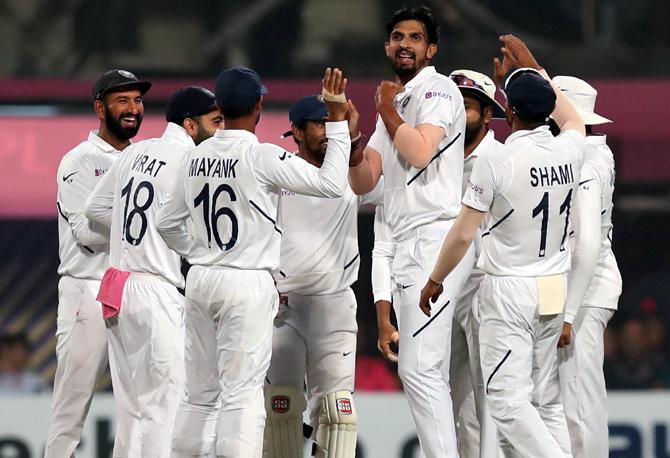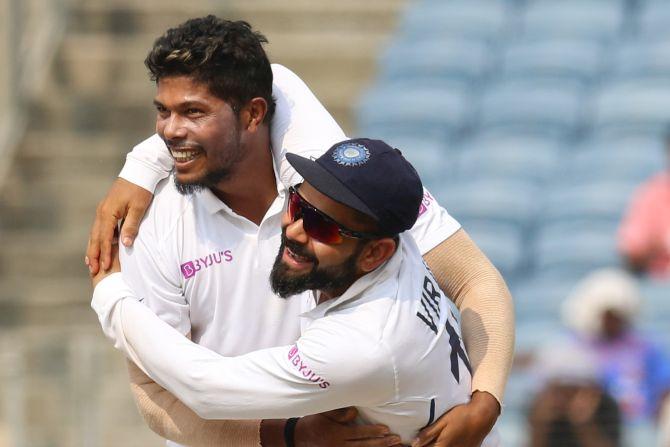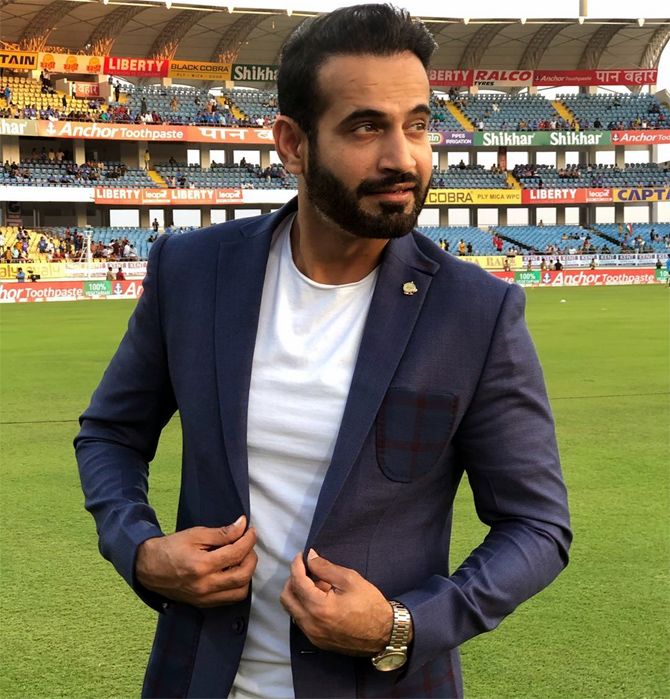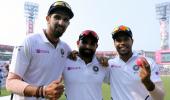'In the future, you will get pacers who will bowl even faster than the current lot because these guys are currently setting new standards.'

Irfan Pathan, the only bowler to take a hat-trick in the first over of a Test match, certainly knows a thing or two about fast bowling.
In his heyday, Irfan could literally make the ball talk as Pakistan's top order found out during his record-breaking hat-trick in the Karachi Test in 2006.
His promising career was hampered by injuries and he only featured in 29 Tests and 120 ODIs after making a promising debut as a 19 year old in 2003 during the Adelaide Test against Australia.
He played a key role in India's T20 World Cup triumph in 2007 and was much sought after in the Indian Premier League for quite a few years.
After a long career with Baroda in domestic cricket, he took up the role of player-cum-mentor last season with Jammu and Kashmir and has since been involved with developing cricket in the Kashmir valley. Irfan's in-depth knowledge of the game and crisp analysis also makes him a popular television commentator.
Irfan reveals the secret behind the rampaging run of the Indian pace trio -- Ishant Sharma, Mohammed Shami and Umesh Yadav -- in the recent home Test series against South Africa and Bangladesh in this fascinating interview with Rediff.com's Harish Kotian.

The fast bowlers dominated against Bangladesh, picking up 33 out of the 40 wickets in a home series. Looking at our performance in the last couple of years, we now seem a land of fast bowlers rather than spinners. What has brought about this change?
A lot of things have changed including the SG ball. In the past, the SG ball used to go soft. There were a lot of complaints and the SG ball was made hard. And if the ball is hard then you will get more pace which will help the fast bowlers. So that makes a lot of difference.
The seam is also quite pronounced. If you take the pink ball, SG was told to make it harder.
If you see fast bowlers bowling with the Kookaburra, it seems like they are bowling quite fast and it is because the ball is hard.
But this is taking nothing away from the Indian fast bowlers, they have been fantastic.
They are top class bowlers and this bowling attack can trouble any batting line-up in any conditions, on any pitch, whether it is the SG ball or any other.
Their training methods have also changed in recent times. I remember when I started training I was told to run for a long time. It was all cricket-specific because we were told not to sprint.
Whatever training we used to do in one hour, nowadays they complete the same in around 20 minutes and it is more effective too.
The focus is now on functional training. By that it means that whatever functions we do when playing cricket, the training is based around that. So when you do functional training, it means your muscles become more strong due to that particular movement.
Bowling is not a natural movement. It involves a lot of twists and turns, it is putting a lot of strain on yourself when bowling each delivery.
From a scientific point of view, we end up putting as much as eight times pressure on the body to bowl each delivery. That is why training is very important. Nowadays training is very specific and that is making a lot of difference.
We see a lot of fast bowlers coming up as compared to when we had mostly medium pacers coming through 10, 12 years ago. What do you attribute this change to?
When Sunil Gavaskar came on the scene, everyone wanted to be like Sunil Gavaskar. The young batsmen in the country idolise Gavaskar or Sachin Tendulkar or Virat Kohli and aspire to be like them.
There came a time when we started producing good fast bowlers, so people started following them and practiced to be like them.
There was a time when we only had swing bowlers in India because everyone was following Kapil Dev. Then came along Zaheer Khan, myself, Ashish Nehra and it changed people's mindset that along with swing you can also bowl fast.
In the future, you will get pacers who will bowl even faster than the current lot because these guys are currently setting new standards.

You played with Ishant Sharma when he started out, including that famous Test win in Perth in 2008. How much has he improved in the last couple of years?
When Ishant Sharma first came into the team, his seam used to land straight, there was a slight tilt towards the batsman, but it never used to scramble. Then came a time when his seam used to scramble and his wrist used to fall.
He has worked on his wrist position and if you see now whenever he bowls, you can see the control he has on his body and at the same time on his length too.
Previously, people used to tell him to pitch it up, but it is only in the last few years that he is pitching it up. That is because he has much more control over the length now. This is because he is in control of his body.
With experience, if you have some problem you know how to rectify it. The most important thing with Ishant's bowling is that despite playing for so many years, his action has not changed much which has also proved to be his big strength.

Mohammed Shami's bowling has been a revelation in the last couple of years. He has emerged as one of the best fast bowlers in the world. What has been the key to his transformation?
Whenever he comes to bowl, Shami has the ability to pick up wickets. It is rare that he will not pick up a wicket in a spell and that is why he has become an important cog in the wheel of the Indian bowling attack.
His seam position is upright, his rhythm is good, but now his fitness has also improved a great deal.
And when he is fit, he is at the top of his game. He looks all charged up when he comes on to bowl. His rhythm is perfect. His action and seam position takes over and he manages to pick up wickets.
Previously when his fitness was not that great, he also struggled with his rhythm and his run up.
His seam is so straight that batsmen sometimes can't predict whether the ball is coming in or going out and that's what makes him such a lethal bowler.
Shami's fitness standards have improved vastly in the last couple of years. Does that help a fast bowler improve his overall bowling?
For any fast bowler, it is very important that they play continuous cricket because that means you are strong and you are injury free.
When you get injured it takes a couple of months to get your rhythm back. In today's times, there is one series after another, so you will miss a lot of cricket.
So when you play cricket continuously, your rhythm is better, your fitness will improve and you will feel stronger. Tthat is what happening with Shami who is really high on confidence at the moment.

Umesh Yadav grabbed his chances with both hands during the recent home Test matches against South Africa and Bangladesh and proved that he can make a difference with the ball when given an opportunity.
If not for Jasprit Bumrah's injury, he would have been on the bench.
Umesh is someone who swings the new ball and reverses the old ball and has matured a lot.
What is your take on his recent good showing?
He has matured a lot in the last couple of years. The one thing that was always spoken about Umesh was that he didn't have much control over his bowling, but now you can see him have the control.
And you get that control when you take early wickets in your spell in a Test match -- he has does that a few times already, picking up wickets in the first over itself.
So that shows you he was in rhythm right from the start and that can only happen when you have control over your bowling, when you are mature enough to know that instead of bowling outside the line of off-stump or down the leg stump, bowl on the stumps and look to pick wickets. That kind of maturity can happen only with experience and age.
These three fast bowlers we spoke about, the most important thing common between them is their fitness and that is what makes them the best in the world today.
Someone like Umesh, who when not playing for India, was turning up in domestic cricket to keep his rhythm going and maintain his fitness.
In the past, Umesh used to employ his wrists a lot to get the ball to swing, but now he uses the follow through to get the ball to move and that is what has helped him a lot.

Has a full time bowling coach helped the fast bowlers?
That has been a big help. Bharat Arun has worked in the NCA (National Cricket Academy) and knows the nitty gritty of fast bowling. He deserves a lot of credit for the success enjoyed by the fast bowlers in recent years.
He has worked a lot on the fast bowlers and the results are there for everyone to see.
There is a feeling that only big names can be successful coaches. But that is not always the case as Arun has shown, which is very good. He has done a good job. If there is continuity, then it will only benefit the players.
Do the pacers now put fear into the opposition batting line-up like the West Indians did in the past?
I agree. You can see it in the results they have achieved. The fast bowlers are picking wickets with the new ball and with the old ball too. What more can you want?
When you put doubt in the batsman's mind, that is half the battle won even before you have bowled a delivery.
You had a pretty good pace attack in your time -- Ajit Agarkar, Zaheer Khan, R P Singh and Ashish Nehra -- who were good in any conditions.
How would you compare them to this current fast bowling attack?
This current Indian fast bowling attack is a complete bowling unit. They can be a handful on any surface or in any conditions.
People say fast bowlers can easily pick wickets in foreign conditions, but it is easier said than done. You need to adjust your length according to the conditions and the pitch on offer.
When I was playing for India we had some very good bowlers like Ajit Agarkar, Zaheer Khan, R P Singh and Ashish Nehra. This current bowling attack has similar quality.
I would not like compare eras, but I can definitely say that this current Indian fast bowling attack is the best in the world at the moment.











